Depositional Setting and Cementation Pattern of Al-Mejarma Beachrocks, Saudi Arabia: A Proxy for the Late Quaternary Red Sea Coastal Evolution
Abstract
:1. Introduction
2. Holocene Climate and Sea Level in the Red Sea Region
3. Area of Study
4. Materials and Methods
5. Results
5.1. Morphology and Lithofacies
5.2. Framework Composition and Cement
5.3. Oxygen and Carbon Isotopic Data
6. Discussion
6.1. Depositional Setting
6.2. Source and Availability of Sediments
6.3. Sediment Transportation and Deposition
6.4. Sea Level and Climate Controls
6.5. Origin of Cement
7. Conclusions
Author Contributions
Funding
Institutional Review Board Statement
Informed Consent Statement
Data Availability Statement
Acknowledgments
Conflicts of Interest
References
- Anthony, E.J. Wave influence in the construction, shaping and destruction of river deltas: A review. Mar. Geol. 2015, 361, 53–78. [Google Scholar] [CrossRef]
- Forde, T.C.; Nedimović, M.R.; Gibling, M.R.; Forbes, D.L. Coastal evolution over the past 3000 years at Conrads Beach, Nova Scotia: The influence of local sediment supply on a paraglacial transgressive system. Estuaries Coasts 2016, 39, 363–384. [Google Scholar] [CrossRef] [Green Version]
- Falkenroth, M.; Adolphs, S.; Cahnbley, M.; Bagci, H.; Kázmér, M.; Mechernich, S.; Hoffmann, G. Biological indicators reveal small-scale sea-level variability during MIS 5e (Sur, Sultanate of Oman). Open Quat. 2020, 6, 1–20. [Google Scholar] [CrossRef] [Green Version]
- Rivers, J.; Engel, M.; Dalrymple, R.; Yousif, R.; Strohmenger, C.J.; Al-Shaikh, I. Are carbonate barrier islands mobile? Insights from a mid to late-Holocene system, Al Ruwais, northern Qatar. Sedimentology 2020, 67, 534–558. [Google Scholar] [CrossRef] [Green Version]
- Mulhern, J.S.; Johnson, C.L.; Green, A.N. When is a barrier island not an island? When it is preserved in the rock record. Front. Earth Sci. 2021, 8, 560437. [Google Scholar] [CrossRef]
- Hein, C.J.; Fitzgerald, D.M.; Cleary, W.J.; Albernaz, M.B.; de Menezes, J.T.; Klein, A.H.D.F. Evidence for a transgressive barrier within a regressive strandplain system: Implications for complex coastal response to environmental change. Sedimentology 2013, 60, 469–502. [Google Scholar] [CrossRef]
- Cooper, J.A. Beachrock formation in low latitudes: Implications for coastal evolutionary models. Mar. Geol. 1991, 98, 145–154. [Google Scholar] [CrossRef]
- Dickinson, W.R. Paleoshoreline record of relative Holocene sea levels on Pacific islands. Earth-Sci. Rev. 2001, 55, 191–234. [Google Scholar] [CrossRef]
- Harvey, N. Holocene coastal evolution: Barriers, beach ridges, and tidal flats of South Australia. J. Coast. Res. 2006, 22, 90–99. [Google Scholar] [CrossRef]
- Kelly, C.S.; Green, A.N.; Cooper, J.A.G.; Wiles, E. Beachrock facies variability and sea level implications: Preliminary study. J. Coast. Res. 2014, 70, 736–742. [Google Scholar] [CrossRef]
- Duong, N.; Lieu, N.T.; Cúc, N.T.; Saito, Y.; Hương, N.T.; Phượng, N.T.; Thuy, A.H. Holocene paleoshoreline changes of the Red River Delta, Vietnam. Rev. Palaeobot. Palynol. 2020, 278, 104235. [Google Scholar] [CrossRef]
- Erginal, A.E. Beachrock as evidence of sea-level lowstand during the Clasical period, Parion antique city, Marmara Sea, Turkey. Geodin. Acta 2012, 25, 96–103. [Google Scholar] [CrossRef] [Green Version]
- Stattegger, K.; Tjallingii, R.; Saito, Y.; Michelli, M.; Thanh, N.T.; Wetzel, A. Mid to late Holocene sea level reconstruction of southeast Vietnam using beachrock and beach-ridge deposits. Glob. Planet. Chang. 2013, 110, 214–222. [Google Scholar] [CrossRef]
- Öztürk, M.Z.; Erginal, A.E.; Kiyak, N.G.; Öztürk, T. Cement fabrics and optical luminescence ages of beachrock, North Cyprus: Implications for Holocene sea-level changes. Quat. Int. 2016, 401, 132–140. [Google Scholar] [CrossRef]
- Spurgeon, D.; Davis, J.R.A.; Shinn, E.A. Formation of ‘beachrock’ at Siesta Key, Florida, and its influence on barrier island development. Mar. Geol. 2003, 200, 19–29. [Google Scholar] [CrossRef]
- Erginal, A.E.; Ekinci, Y.L.; Demirci, A.; Bozcu, M.; Ozturk, M.Z.; Avcioglu, M.; Oztura, M.Z. First record of beachrock on Black Sea coast of Turkey: Implications for late Holocene sea-level fluctuations. Sediment. Geol. 2013, 294, 294–302. [Google Scholar] [CrossRef]
- Mauz, B.; Vacchi, M.; Green, A.; Hoffmann, G.; Cooper, A. Beachrock: A tool for reconstructing relative sea level in the far-field. Mar. Geol. 2015, 362, 1–16. [Google Scholar] [CrossRef]
- Holail, H.; Rashed, M. Stable isotopic composition of carbonate cemented recent beachrock along the Mediterranean and the Red Sea coasts of Egypt. Mar. Geol. 1992, 106, 141–148. [Google Scholar] [CrossRef]
- Kelletat, D. Beachrock as sea level indicator? Remarks from a geomorphological point of view. J. Coast. Res. 2006, 22, 1555–1564. [Google Scholar] [CrossRef]
- Vousdoukas, M.I.; Velegrakis, A.F.; Plomaritis, T.A. Beachrock occurrence, characteristics, formation mechanisms and impacts. Earth-Sci. Rev. 2007, 85, 23–46. [Google Scholar] [CrossRef]
- Erginal, A.E.; Kıyak, N.G.; Öztürk, B. Investigation of beachrock using microanalyses and OSL dating: A case study from Bozcaada Island, Turkey. J. Coast. Res. 2010, 26, 350–358. [Google Scholar] [CrossRef]
- Danjo, T.; Kawasaki, S. Formation mechanisms of beachrocks in Okinawa and Ishikawa, Japan, with a focus on cements. Mater. Trans. 2014, 55, 493–500. [Google Scholar] [CrossRef] [Green Version]
- Júnior, A.V.; Paes, B.C.; Vieira, M.M.; Sial, A.N.; Neumann, V.H. Diagenesis of Holocene beachrock in northeastern Brazil: Petrology, isotopic evidence and age. Quat. Environ. Geosci. 2018, 2, 26–35. [Google Scholar]
- Nayanthara, P.G.N.; Dassanayake, A.B.N.; Nakashima, K.; Kawasaki, S. Distribution and cementation characteristics of beachrocks along southern, southwestern and western coast of Sri Lanka. J. Sediment. Environ. 2021, 6, 93–106. [Google Scholar] [CrossRef]
- Bathurst, R.G.C. Carbonate Sediments and Their Diagenesis. Developments in Sedimentology 12; Elsevier: Amsterdam, The Netherlands, 1975; p. 658. [Google Scholar]
- Milliman, J.D. Marine Carbonates. Part 1, Recent Sedimentary Carbonates; Springer: New York, NY, USA, 1974; p. 375. [Google Scholar]
- Moore, C.H.; Billings, G.K. Preliminary model of beachrock cementation, Grand Cayman Island, B.W.I. In Carbonate Cements; Bricker, O.P., Ed.; Johns Hopkins University Press: Baltimore, MD, USA, 1971; pp. 41–43. [Google Scholar]
- Hanor, J.S. Precipitation of beachrock cements: Mixing of marine and meteoric waters vs. CO2-degassing. J. Sediment. Petrol. 1978, 48, 489–501. [Google Scholar]
- Neumeier, U. Experimental modelling of beachrock cementation under microbial influence. Sediment. Geol. 1999, 126, 35–46. [Google Scholar] [CrossRef]
- Webb, G.E.; Jell, J.S.; Baker, J.C. Cryptic intertidal microbialites in beachrock, Heron Island, Great Barrier Reef: Implications for the origin of microcrystalline beachrock cement. Sediment. Geol. 1999, 126, 317–334. [Google Scholar] [CrossRef]
- Wiles, E.; Green, A.N.; Cooper, J.A.G. Rapid beachrock cementation on a South African beach: Linking morphodynamics and cement style. Sediment. Geol. 2018, 378, 13–18. [Google Scholar] [CrossRef]
- Al-Ramadan, K. Diagenesis of Holocene beachrocks: A comparative study between the Arabian Gulf and the Gulf of Aqaba, Saudi Arabia. Arab. J. Geosci. 2014, 7, 4933–4942. [Google Scholar] [CrossRef]
- Ghandour, I.M.; Al-Washmi, H.A.; Bantan, R.A.; Gadallah, M.M. Petrographical and petrophysical characteristics of asynchronous beachrocks along Al-Shoaiba Coast, Red Sea, Saudi Arabia. Arab. J. Geosci. 2014, 7, 355–365. [Google Scholar] [CrossRef]
- Koeshidayatullah, A.; Al-Ramadan, K. Unraveling cementation environment and patterns of Holocene beachrocks in the Arabian Gulf and the Gulf of Aqaba: Stable isotope approach. Geol. Q. 2014, 58, 207–216. [Google Scholar] [CrossRef] [Green Version]
- Haredy, R.A.; Ghandour, I.M.; Erginal, A.E.; Bozcu, M. Beachrock cementation patterns along the Gulf of Aqaba coast, Saudi Arabia. Arab. J. Sci. Eng. 2019, 44, 479–487. [Google Scholar] [CrossRef]
- Mannaa, A.A.; Haredy, R.A.; Ghandour, I.M. Beachrock as a Paleoshoreline Indicator: Example from Wadi Al-Hamd, South Al-Wajh, Saudi Arabia. J. Mar. Sci. Eng. 2021, 9, 984. [Google Scholar] [CrossRef]
- DeMenocal, P.; Ortiz, J.; Guilderson, T.; Sarnthein, M. Abrupt onset and termination of the African humid period: Rapid climate responses to gradual insolation forcing. Quat. Sci. Rev. 2000, 19, 347–361. [Google Scholar] [CrossRef]
- Mitrovica, J.X.; Milne, G.A. On the origin of late Holocene sea level highstands within equatorial ocean basins. Quat. Sci. Rev. 2002, 21, 2179–2190. [Google Scholar] [CrossRef]
- Jado, A.R.; Zötl, J.G. Quaternary Period in Saudi Arabia; Springer: Berlin/Heidelberg, Germany, 1984; Volume 2, p. 360. [Google Scholar]
- Ritchie, J.C.; Eyles, C.H.; Haynes, C.V. Sediment and pollen evidence for an early to mid-Holocene humid period in the eastern Sahara. Nature 1985, 314, 352–355. [Google Scholar] [CrossRef]
- Bailey, G. The Red Sea, coastal landscapes, and hominin dispersals. In The Evolution of Human Populations in Arabia; Petraglia, M.D., Rose, J.I., Eds.; Springer: Berlin/Heidelberg, Germany, 2010; pp. 15–37. [Google Scholar]
- Engel, M.; Matter, A.; Parker, A.G.; Parton, A.; Petraglia, M.D.; Preston, G.; Preusser, F. Lakes or wetlands? A comment on “The middle Holocene climatic records from Arabia: Reassessing lacustrine environments, shift of ITCZ in Arabian Sea, and impacts of the southwest Indian and African monsoons” by Enzel et al. Glob. Planet. Chang. 2017, 148, 258–267. [Google Scholar] [CrossRef] [Green Version]
- Biton, E.; Gildor, H.; Trommer, G.; Siccha, M.; Kucera, M.; van der Meer, M.T.; Schouten, S. Sensitivity of Red Sea circulation to monsoonal variability during the Holocene: An integrated data and modeling study. Paleoceanography 2010, 25, PA4209. [Google Scholar] [CrossRef]
- Arz, H.W.; Lamy, F.; Pätzold, J.; Müller, P.J.; Prins, M. Mediterranean moisture source for an early-Holocene humid period in the northern Red Sea. Science 2003, 300, 118–121. [Google Scholar] [CrossRef] [Green Version]
- Lézine, A.M.; Robert, C.; Cleuziou, S.; Inizan, M.L.; Braemer, F.; Saliège, J.F.; Sylvestre, F.; Tiercelin, J.J.; Crassard, R.; Méry, S.; et al. Climate change and human occupation in the southern Arabian lowlands during the last deglaciation and the Holocene. Glob. Planet. Chang. 2010, 72, 412–428. [Google Scholar] [CrossRef]
- Morcos, S.A. Physical and chemical oceanography of the Red Sea. Oceanogr. Mar. Biol. Annu. Rev. 1970, 8, 73–202. [Google Scholar]
- Sofianos, S.S.; Johns, W.E. An oceanic general circulation model (OGCM) investigation of the Red Sea circulation, 1. Exchange between the Red Sea and the Indian Ocean. J. Geophys. Res. Ocean. 2002, 107, 17-1–17-11. [Google Scholar] [CrossRef]
- Manaa, A.A.; Jones, B.G.; McGregor, H.V.; Zhao, J.X.; Price, D.M. Dating Quaternary raised coral terraces along the Saudi Arabian Red Sea coast. Mar. Geol. 2016, 374, 59–72. [Google Scholar] [CrossRef] [Green Version]
- Fouda, M.M.; Gerges, M.A. Implication of Climate Change in the Red Sea and Gulf of Aden Region: An Overview; United Nations Environment Programme, Regional Seas Reports and Studies: Nairobi, Kenya, 1994. [Google Scholar]
- Shanas, P.R.; Aboobacker, V.M.; Albarakati, A.M.A.; Zubier, K.M. Superimposed wind-waves in the Red Sea. Ocean. Eng. 2017, 138, 9–22. [Google Scholar] [CrossRef]
- Langodan, S.; Cavaleri, L.; Pomaro, A.; Portilla, J.; Abualnaja, Y.; Hoteit, I. Unraveling climatic wind and wave trends in the Red Sea using wave spectra partitioning. J. Clim. 2018, 31, 1881–1895. [Google Scholar] [CrossRef]
- Langodan, S.; Cavaleri, L.; Viswanadhapalli, Y.; Hoteit, I. The Red Sea: A natural laboratory for wind and wave modeling. J. Phys. Oceanogr. 2014, 44, 3139–3159. [Google Scholar] [CrossRef] [Green Version]
- Jiang, H.; Farrar, J.T.; Beardsley, R.C.; Chen, R.; Chen, C. Zonal surface wind jets across the Red Sea due to mountain gap forcing along both sides of the Red Sea. Geophys. Res. Lett. 2009, 36, L19605. [Google Scholar] [CrossRef] [Green Version]
- Kemp, A.C.; Horton, B.; Donnelly, J.P.; Mann, M.E.; Vermeer, M.; Rahmstorf, S. Climate related sea-level variations over the past two millennia. Proc. Natl. Acad. Sci. USA 2011, 108, 11017–11022. [Google Scholar] [CrossRef] [PubMed] [Green Version]
- Woodroffe, C.D.; Webster, J.M. Coral reefs and sea-level change. Mar. Geol. 2014, 352, 248–267. [Google Scholar] [CrossRef]
- Lambeck, K.; Rouby, H.; Purcell, A.; Sun, Y.; Sambridge, M. Sea level and global ice volumes from the last glacial maximum to the Holocene. Proc. Natl. Acad. Sci. USA 2014, 111, 15296–15303. [Google Scholar] [CrossRef] [PubMed] [Green Version]
- Brooke, B.P.; Huang, Z.; Nicholas, W.A.; Oliver, T.S.; Tamura, T.; Woodroffe, C.D.; Nichol, S.L. Relative sea-level records preserved in Holocene beach-ridge strandplains—An example from tropical northeastern Australia. Mar. Geol. 2019, 411, 107–118. [Google Scholar] [CrossRef]
- Dougherty, A.J.; Thomas, Z.A.; Fogwill, C.; Hogg, A.; Palmer, J.; Rainsley, E.; Williams, A.N.; Ulm, S.; Rogers, K.; Jones, B.G.; et al. Redating the earliest evidence of the mid-Holocene relative sea-level highstand in Australia and implications for global sea-level rise. PLoS ONE 2019, 14, e0218430. [Google Scholar] [CrossRef] [PubMed] [Green Version]
- Rushby, G.T.; Richards, G.T.; Gehrels, W.R.; Anderson, W.P.; Bateman, M.D.; Blake, W.H. Testing the mid-Holocene relative sea-level highstand hypothesis in north Wales, United Kingdom. Holocene 2019, 29, 1491–1502. [Google Scholar] [CrossRef]
- Shaked, Y.; Marco, S.; Lazar, B.; Stein, M.; Cohen, C.; Sass, E.; Agnon, A. Late Holocene shorelines at the Gulf of Aqaba: Migrating shorelines under conditions of tectonic and sea level stability. Eur. Geosci. Union Stephan Mueller Spec. Publ. Ser. 2002, 2, 1–7. [Google Scholar] [CrossRef]
- Hein, C.J.; FitzGerald, D.M.; Milne, G.A.; Bard, K.; Fattovich, R. Evolution of a Pharaonic harbor on the Red Sea: Implications for coastal response to changes in sea level and climate. Geology 2011, 39, 687–690. [Google Scholar] [CrossRef]
- Al-Mikhlafi, A.S.; Hibbert, F.D.; Edwards, L.R.; Cheng, H. Holocene relative sea-level changes and coastal evolution along the coastlines of Kamaran Island and As-Salif Peninsula, Yemen, southern Red Sea. Quat. Sci. Rev. 2021, 252, 106719. [Google Scholar] [CrossRef]
- Behairy, A.K.A.; Durgaprasada Rao, N.V.N.; El-Shater, A. A siliciclastic coastal sabkha, Red Sea coast, Saudi Arabia. J. King Abdulaziz Univ. Mar. Sci. 1991, 2, 65–77. [Google Scholar] [CrossRef]
- Ghandour, I.M.; Haredy, R.A. Facies analysis and sequence stratigraphy of Al-Kharrar Lagoon coastal sediments, Rabigh Area, Saudi Arabia: Impact of sea level and climate changes on coastal evolution. Arab. J. Sci. Eng. 2019, 44, 505–520. [Google Scholar] [CrossRef]
- Ghandour, I.M.; Majeed, J.; Al-Zubieri, A.G.; Mannaa, A.A.; Aljahdali, M.H.; Bantan, R.A. Late Holocene Red Sea coastal evolution: Evidence from shallow subsurface sedimentary facies, north Al-Wajh, Saudi Arabia. Thalass. Int. J. Mar. Sci. 2021, 37, 1–12. [Google Scholar]
- Ghandour, I.M.; Al-Zubieri, A.G.; Basaham, A.S.; Mannaa, A.A.; Al-Dubai, T.A.; Jones, B.G. Mid-late Holocene paleoenvironmental and sea level reconstruction on the Al Lith Red Sea coast, Saudi Arabia. Front. Mar. Sci. 2021, 8, 677010. [Google Scholar] [CrossRef]
- Abu-Zied, R.H.; Bantan, R.A. Palaeoenvironment, palaeoclimate and sea-level changes in the Shuaiba Lagoon during the late Holocene (last 3.6 ka), eastern Red Sea coast, Saudi Arabia. Holocene 2015, 25, 1301–1312. [Google Scholar] [CrossRef]
- Bantan, R.A.; Abu-Zied, R.H.; Al-Dubai, T.A. Late Holocene environmental changes in a sediment core from Al-Kharrar Lagoon, eastern Red Sea Coast, Saudi Arabia. Arab. J. Sci. Eng. 2019, 44, 6557–6570. [Google Scholar] [CrossRef]
- Basaham, A.S.; El Sayed, M.A.; Ghandour, I.M.; Masuda, H. Geochemical background for the Saudi Red Sea coastal systems and its implication for future environmental monitoring and assessment. Environ. Earth Sci. 2015, 74, 4561–4570. [Google Scholar] [CrossRef]
- Basaham, A.S.; Ghandour, I.M.; Haredy, R. Controlling factors on the geochemistry of Al-Shuaiba and Al-Mejarma coastal lagoons, Red Sea, Saudi Arabia. Open Geosci. 2019, 11, 426–439. [Google Scholar] [CrossRef] [Green Version]
- Lisitzin, E. Sea Level Changes; Elsevier: Amsterdam, The Netherlands, 1974. [Google Scholar]
- Johnson, P.R. Explanatory Notes to the Map of Proterozoic Geology of Western Saudi Arabia; Technical Report; Saudi Geological Survey: Jeddah, Saudi Arabia, 2006. [Google Scholar]
- Greenwood, W.R.; Stoeser, D.B.; Fleck, R.J.; Stacey, J.S. Late Proterozoic Island-Arc Complexes and Tectonic Belts in the Southern Part of the Arabian Shield, Kingdom of Saudi Arabia; Open-File Report, 1982-83-296; Ministry of Petroleum and Mineral Resources, Deputy Ministry for Mineral Resources: Jeddah, Saudi Arabia, 1982.
- Goldsmith, J.R.; Graf, D.L.; Heard, H.C. Lattice constants of the calcium-magnesium carbonates. Am. Mineral. 1961, 46, 453–457. [Google Scholar]
- Craig, H. Isotopic standards for carbon and oxygen correction factors for mass spectrometric analysis of carbon dioxide. Geochim. Cosmochim. Acta 1957, 12, 133–149. [Google Scholar] [CrossRef]
- Keith, M.L.; Weber, J.N. Carbon and oxygen isotopic composition of selected limestones and fossils. Geochim. Cosmochim. Acta 1964, 28, 1787–1816. [Google Scholar] [CrossRef]
- Reading, H.G. Clastic coast. In Sedimentary Environments: Processes, Facies and Stratigraphy; Reading, H.G., Ed.; Blackwell Science: Oxford, UK, 1996; pp. 154–231. [Google Scholar]
- Lessa, G.C.; Angulo, R.J.; Giannini, P.C.; Arau´jo, A.D. Stratigraphy and Holocene evolution of a regressive barrier in south Brazil. Mar. Geol. 2000, 165, 87–108. [Google Scholar] [CrossRef]
- González-Villanueva, R.; Pérez-Arlucea, M.; Costas, S.; Bao, R.; Otero, X.L.; Goble, R. 8000 years of environmental evolution of barrier-lagoon systems emplaced in coastal embayments (NW Iberia). Holocene 2015, 25, 1786–1801. [Google Scholar] [CrossRef]
- Bezzi, A.; Casagrande, G.; Martinucci, D.; Pillon, S.; del Grande, C.; Fontolan, G. Modern sedimentary facies in a progradational barrier-spit system: Goro lagoon, Po delta, Italy. Estuar. Coast. Shelf Sci. 2019, 227, 106323. [Google Scholar] [CrossRef]
- McCubbin, D.G. Barrier-island and strand-plain facies. In Sandstone Depositional Environments; Scholle, P.A., Darwin Spearing, D., Eds.; AAPG Memoir: Tulsa, OK, USA, 1982; Volume 31, pp. 247–279. [Google Scholar]
- Clifton, H.E. A re-examination of facies models for clastic shorelines. In Facies Models Revisited; Posamentier, H.G., Walker, R.G., Eds.; SEPM Special Publication: Tulsa, OK, USA, 2006; Volume 84, pp. 293–337. [Google Scholar]
- Lindhorst, S.; Betzler, C.; Hass, H.C. The sedimentary architecture of a Holocene barrier spit (Sylt, German Bight): Swash-bar accretion and storm erosion. Sediment. Geol. 2008, 206, 1–16. [Google Scholar] [CrossRef]
- Van Heteren, S. Barrier systems. In Coastal Environments and Global Change; Masselink, G., Gehrels, R., Eds.; John Wiley and Sons: Hoboken, NJ, USA, 2015; pp. 194–226. [Google Scholar]
- Sousa, C.; Boski, T.; Pereira, L. Holocene evolution of a barrier island system, Ria Formosa, south Portugal. Holocene 2019, 29, 64–76. [Google Scholar] [CrossRef]
- FitzGerald, D.M.; Rosen, P.S. Glaciated Coasts; Academic Press: London, UK, 1987. [Google Scholar]
- FitzGerald, D.; van Heteren, S. Classification of paraglacial barrier systems: Coastal New England, U.S.A. Sedimentology 1999, 46, 1083–1108. [Google Scholar] [CrossRef]
- Sloss, C.R.; Jones, B.G.; Murray-Wallace, C.V.; McClennen, C.E. Holocene sea level fluctuations and the sedimentary evolution of a barrier estuary: Lake Illawarra, New South Wales, Australia. J. Coast. Res. 2005, 21, 943–959. [Google Scholar] [CrossRef]
- Joury, M.R.F.; James, N.P.; James, C. Nearshore cool-water carbonate sedimentation and provenance of Holocene calcareous strandline dunes, southeastern Australia. Aust. J. Earth Sci. 2018, 65, 221–242. [Google Scholar] [CrossRef]
- Durgaprasada Rao, N.V.N.; Behairy, A.K.A. Intertidal conglomerate south of Yanbu—An episodic clastic deposit in the eastern Red Sea. Palaeogeogr. Palaeoclimatol. Palaeoecol. 1987, 58, 221–228. [Google Scholar] [CrossRef]
- Fruergaard, M.; Tessier, B.; Poirier, C.; Mouazé, D.; Weill, P.; Noël, S. Depositional controls on a hypertidal barrier-spit system architecture and evolution, Pointe du Banc spit, north-western France. Sedimentology 2020, 67, 502–533. [Google Scholar] [CrossRef]
- Flemming, B.W. Siliciclastic back-barrier tidal flats. In Principles of Tidal Sedimentology; Davis, R.A., Dalrymple, R.W., Eds.; Springer: Berlin/Heidelberg, Germany, 2012; pp. 231–267. [Google Scholar]
- Storms, J.E.A. Event-based stratigraphic simulation of wave-dominated shallow-marine environments. Mar. Geol. 2003, 199, 83–100. [Google Scholar] [CrossRef]
- Aagaard, T.; Davidson-Arnott, R.; Greenwood, B.; Nielsen, J. Sediment supply from shoreface to dunes: Linking sediment transport measurements and long-term morphological evolution. Geomorphology 2004, 60, 205–224. [Google Scholar] [CrossRef]
- Snedden, J.W.; Nummedal, D. Coherence of surf zone and shelf current flow on the Texas (USA) coastal margin: Implications for interpretation of paleo-current measurements in ancient coastal sequences. Sediment. Geol. 1990, 67, 221–236. [Google Scholar] [CrossRef]
- Reineck, H.E.; Singh, I.B. Depositional Sedimentary Environments with Reference to Terrigenous Clastics; Springer: Berlin/Heidelberg, Germany, 1980. [Google Scholar]
- Klein, D. Sandstone Depositional Models for Exploration for Fossil Fuels; International Human Resources Development Corporation: Boston, MA, USA, 1982. [Google Scholar]
- Fox, W.T.; Davis, R.J. Seasonal variation in beach erosion and sedimentation on the Oregon Coast. Geol. Soc. Am. Bull. 1978, 89, 1541–1549. [Google Scholar] [CrossRef]
- Peltier, W.R. On eustatic sea level history: Last Glacial Maximum to Holocene. Quat. Sci. Rev. 2002, 21, 377–396. [Google Scholar] [CrossRef]
- Clemmensen, L.B.; Andreasen, F.; Nielsen, S.T.; Sten, E. The late Holocene coastal dunefield at Vejers, Denmark: Characteristics, sand budget and depositional dynamics. Geomorphology 1996, 17, 79–98. [Google Scholar] [CrossRef]
- Psuty, N.P.; Eugénia, M.; Moreira, S.A. Holocene sedimentation and sea level rise in the Sado Estuary, Portugal. J. Coast. Res. 2000, 16, 125–138. [Google Scholar]
- Walker, R.G.; James, N.P. Facies Models Response to Sea Level Change, 2nd ed.; Geological Association of Canada: St. John’s, NS, Canada, 1992; p. 409. [Google Scholar]
- De Falco, G.; Antonioli, F.; Fontolan, G.; lo Presti, V.; Simeone, S.; Tonielli, R. Early cementation and accommodation space dictate the evolution of an overstepping barrier system during the Holocene. Mar. Geol. 2015, 369, 52–66. [Google Scholar] [CrossRef]
- Moore, C.H. Carbonate Diagenesis and Porosity; Elsevier: Amsterdam, The Netherlands, 1989. [Google Scholar]
- Longman, M.W. Carbonate diagenetic textures from near surface diagenetic environments. Am. Assoc. Pet. Geol. Bull. 1980, 64, 461–487. [Google Scholar]
- James, N.P.; Choquette, P.W. Limestone: The sea floor diagenetic environment. In Diagenesis; McIlreath, I., Morrow, D., Eds.; Canada Geological Association of Canada Reprint Series: St John’s, ND, Canada, 1990; pp. 13–34. [Google Scholar]
- Scholle, P.A.; Ulmer-Scholle, D.S. A color guide to the petrography of carbonate rocks: Grains, textures, porosity, diagenesis. Am. Assoc. Pet. Geol. Mem. 2003, 77, 1–474. [Google Scholar]
- Vieira, M.M.; Sial, A.N.; de Ros, L.F.; Morad, S. Origin of Holocene beachrock cements in northeastern Brazil: Evidence from carbon and oxygen isotopes. J. South Am. Earth Sci. 2017, 79, 401–408. [Google Scholar] [CrossRef]
- Hopley, D. Beachrock as sea level indicator. In Sea Level Research; van de Plassche, O., Ed.; Great Yarmouth: Galliard Printers, UK, 1986; pp. 157–173. [Google Scholar]
- Holail, H.M.; Shaaban, M.N.; Mansour, A.S. Cementation of Holocene beachrock in the Aqaba and the Arabian Gulfs: Comparative study. Carbonates Evaporites 2004, 19, 142–150. [Google Scholar] [CrossRef]
- Hillgärtner, H.; Dupraz, C.; Hug, W. Microbially induced cementation of carbonate sands: Are micritic meniscus cements good indicators of vadose diagenesis? Sedimentology 2001, 48, 117–131. [Google Scholar] [CrossRef]
- Calvet, F.; Cabrera, M.C.; Carracedo, J.C.; Mangas, J.; Pérez-Torrado, F.J.; Recio, C.; Travé, A. Beachrocks from the island of La Palma (Canary Islands, Spain). Mar. Geol. 2003, 197, 75–93. [Google Scholar] [CrossRef]
- Friedman, G.M. Climatic significance of Holocene beachrock sites along shorelines of the Red Sea. Am. Assoc. Pet. Geol. Bull. 2005, 89, 849–852. [Google Scholar] [CrossRef]
- Vieira, M.M.; de Ros, L.F. Cementation patterns and genetic implications of Holocene beachrocks from northeastern Brazil. Sediment. Geol. 2006, 192, 207–230. [Google Scholar] [CrossRef]
- Hoefs, J. Stable Isotope Geochemistry; Springer: Berlin/Heidelberg, Germany, 1997. [Google Scholar]
- Woodroffe, C.D. Coasts: Form, Process, and Evolution; Cambridge University Press: Cambridge, UK, 2003. [Google Scholar]
- Dullo, W.C.; Montaggioni, L. Modern Red Sea coral reefs: A review of their morphologies and zonation. In Sedimentary and Tectonic Evolution of Rift Basins–The Red Sea-Gulf of Aden; Purser, B.H., Bosence, D.W.J., Eds.; Springer: Berlin/Heidelberg, Germany, 1998; pp. 583–594. [Google Scholar]
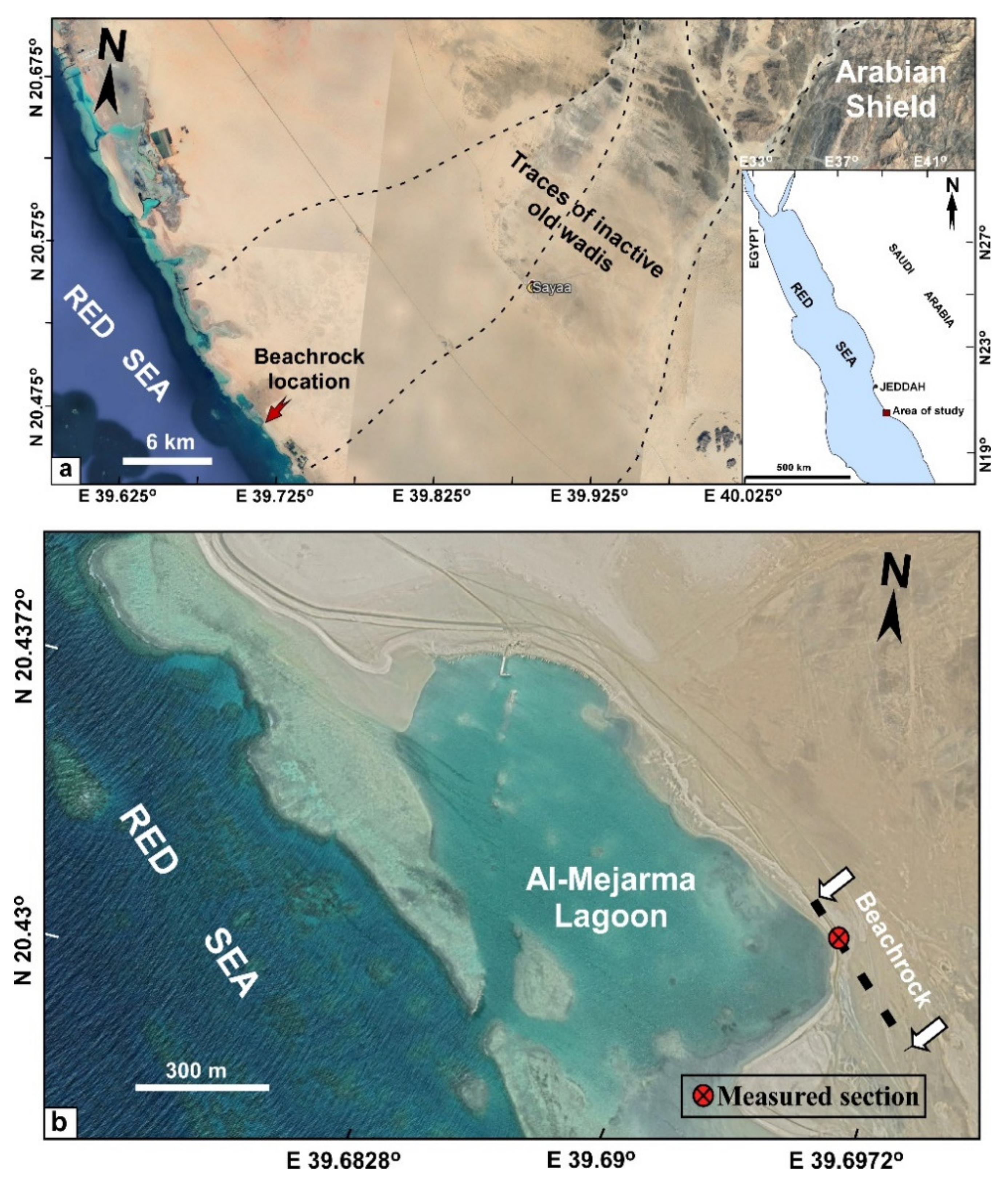
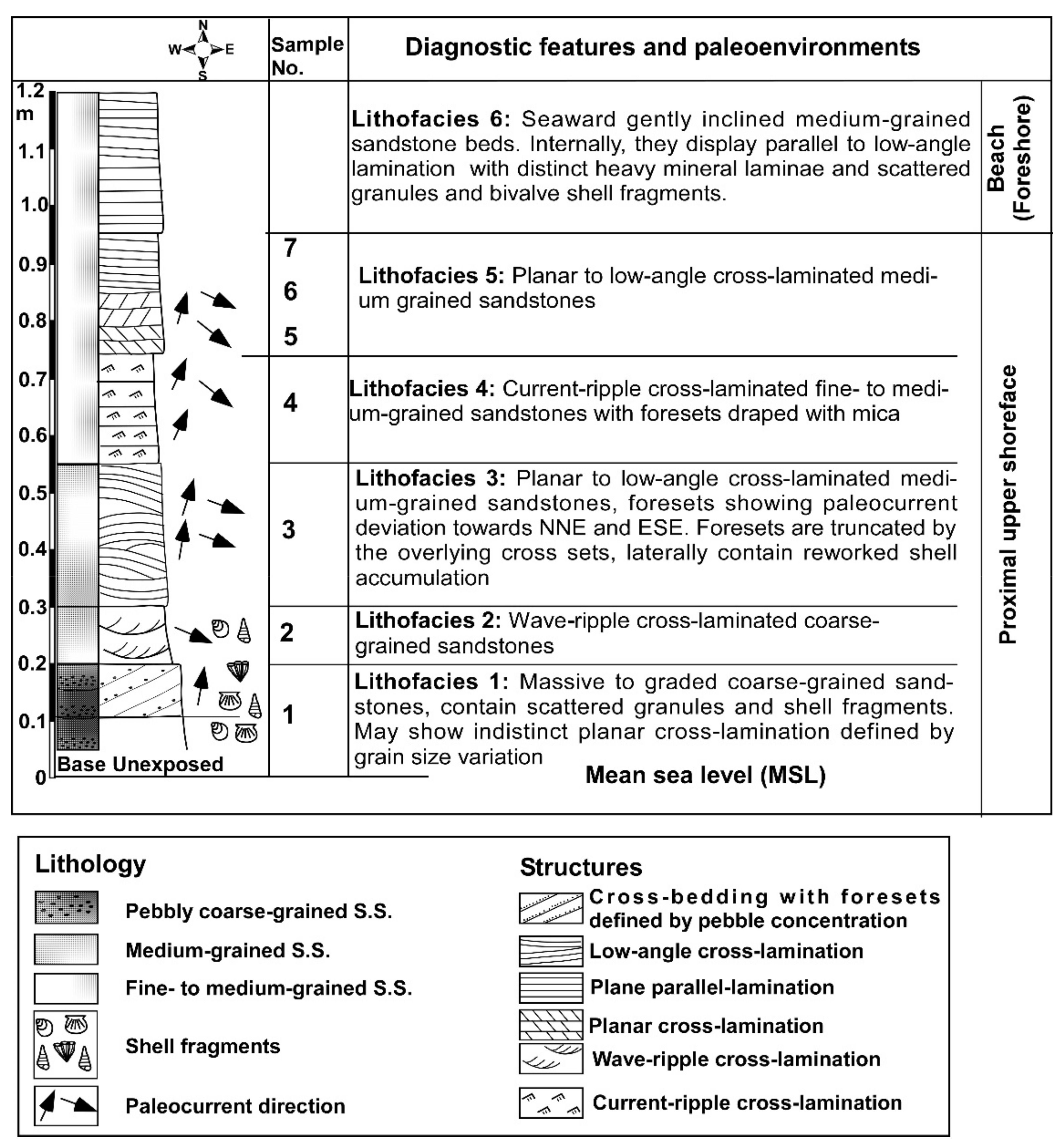
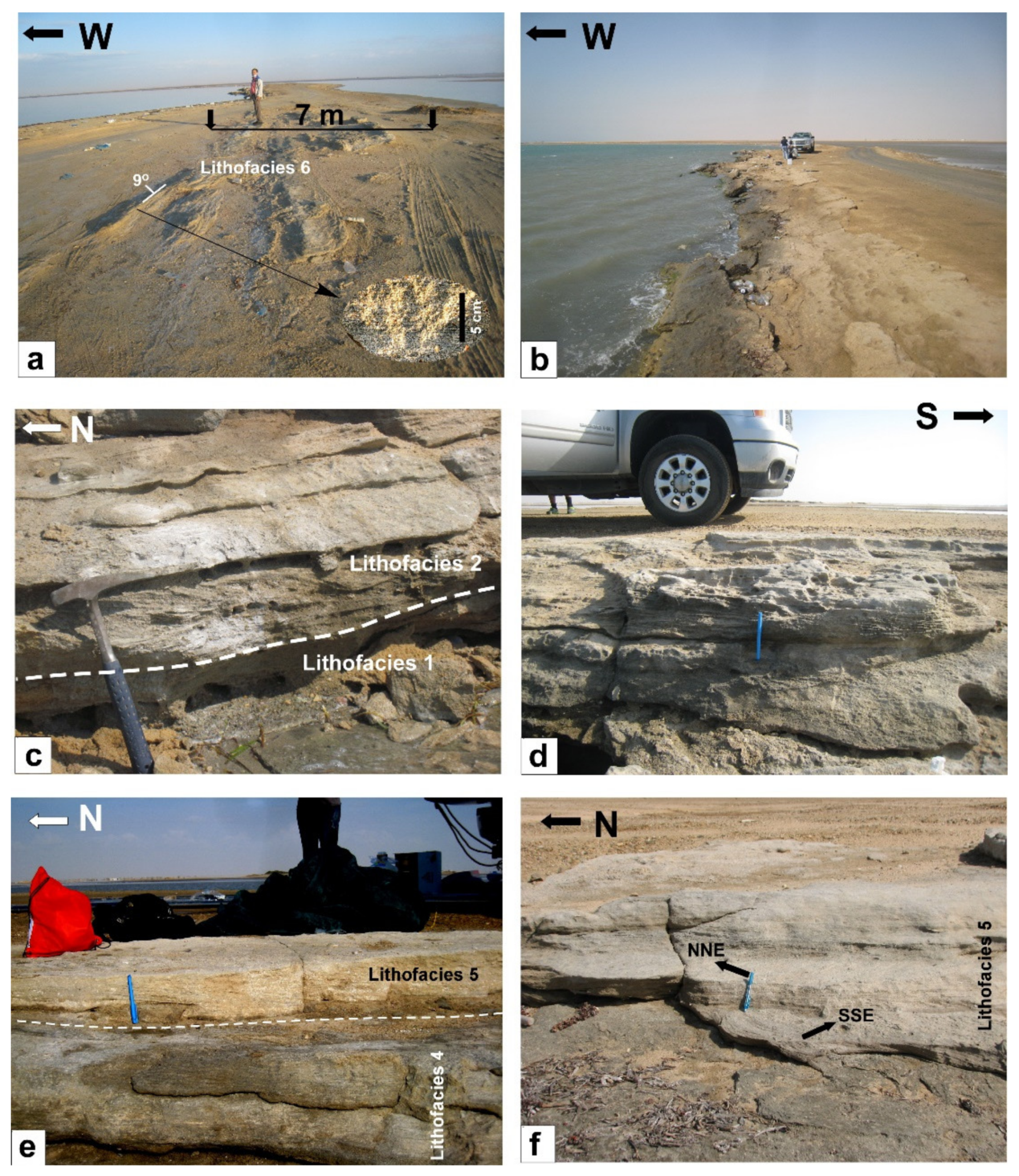
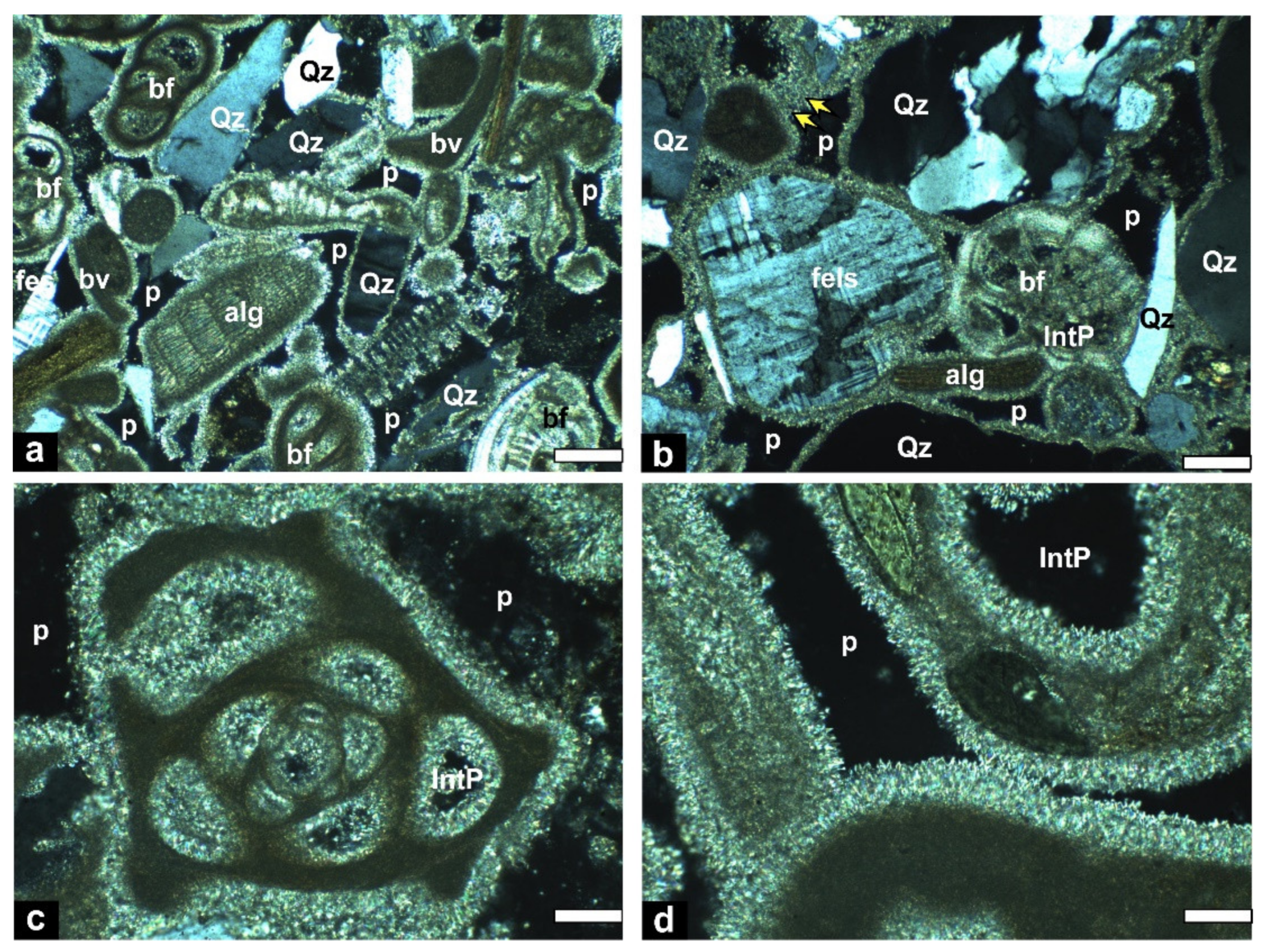
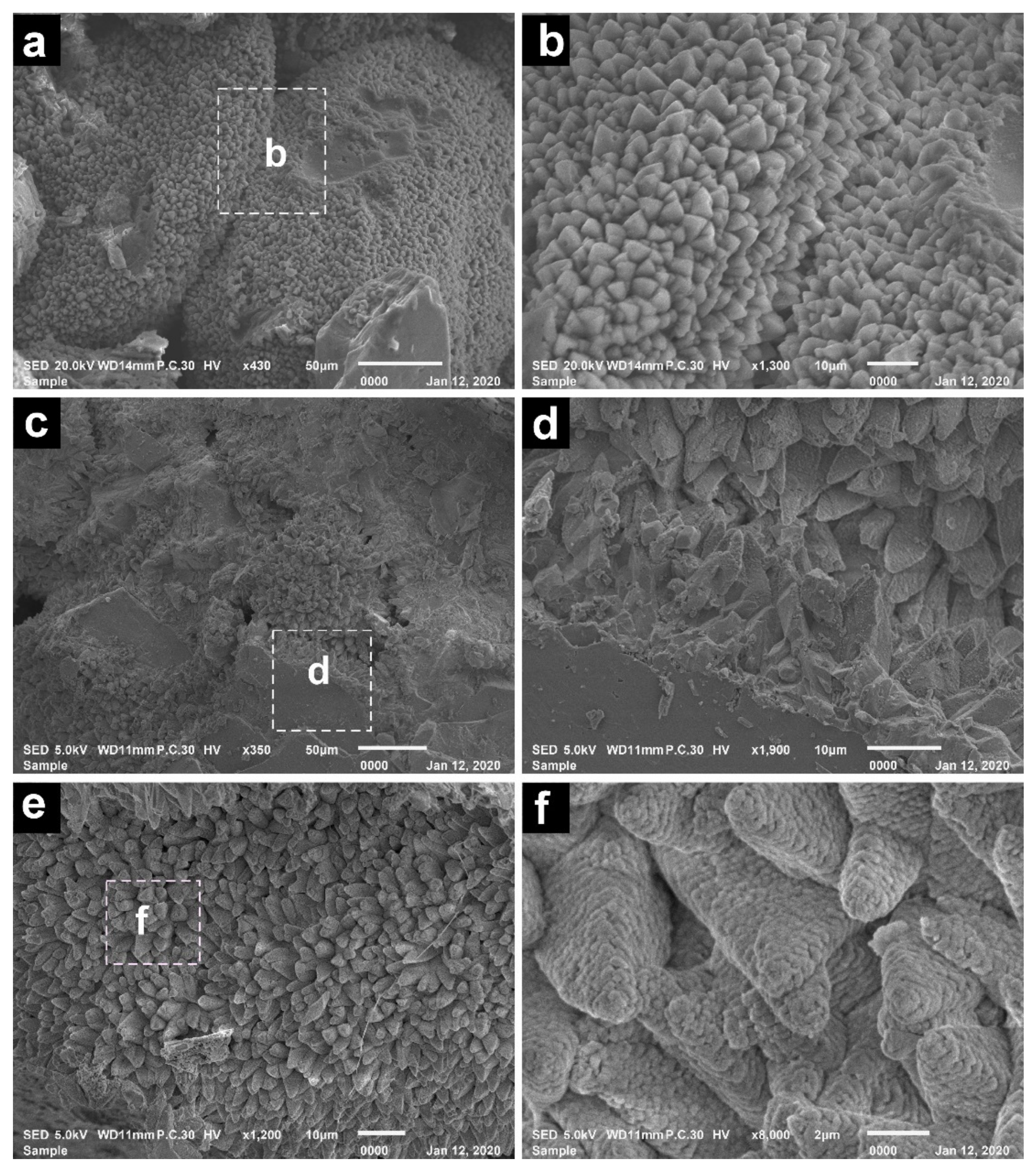
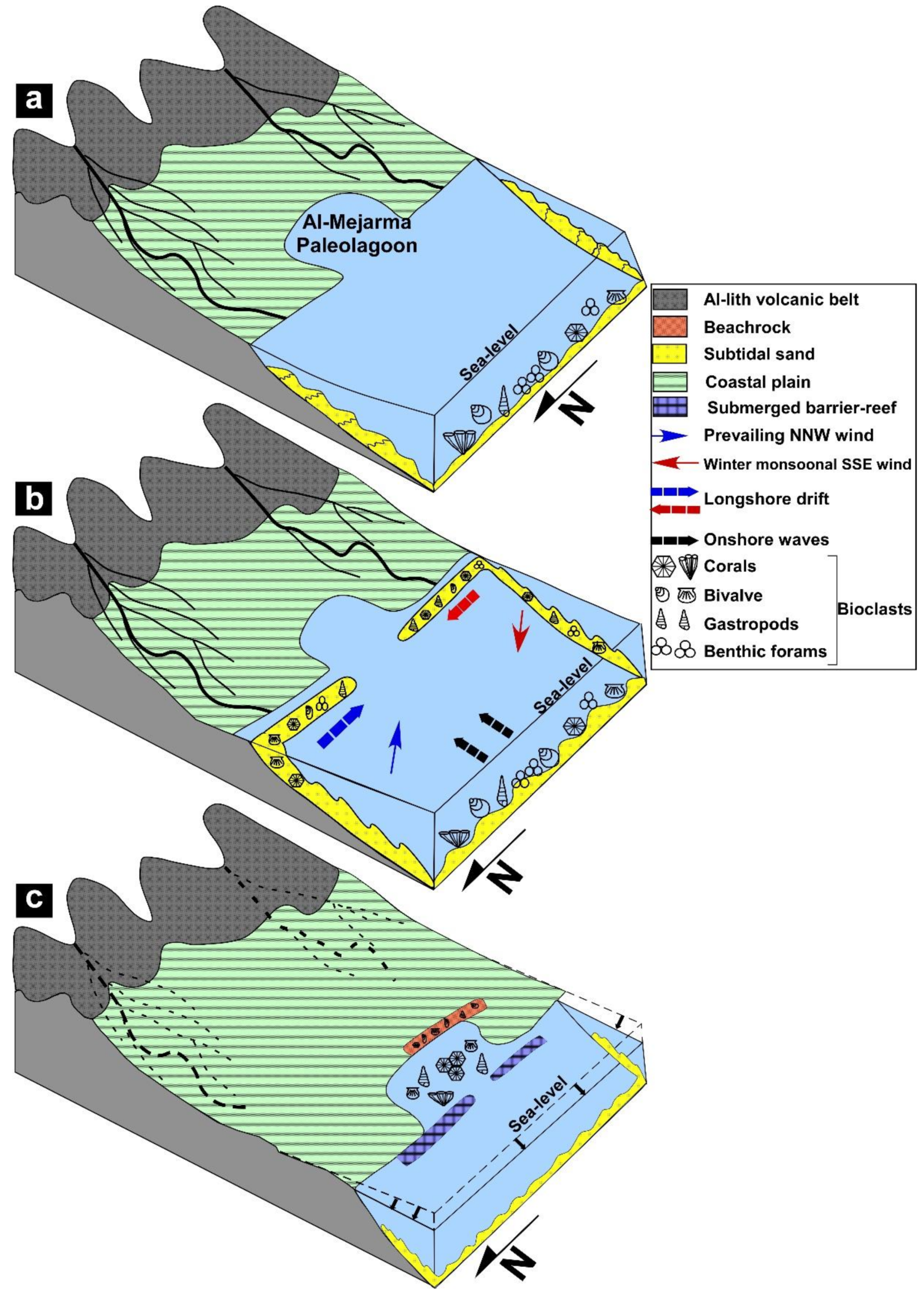
| Sample | CaCO3 % | δ13CVPDB | δ13OVPDB | Z |
|---|---|---|---|---|
| 7 | 68 | 3.64 | 0.54 | 135.0 |
| 6 | 31 | 3.75 | 0.31 | 135.1 |
| 5 | 54 | 3.78 | 0.10 | 135.1 |
| 4 | 52 | 3.88 | 0.68 | 135.6 |
| 3 | 51 | 3.48 | 0.37 | 134.6 |
| 2 | 48 | 3.32 | 0.33 | 134.3 |
| 1 | 36 | 3.65 | 0.73 | 135.1 |
| Min | 31 | 3.32 | 0.10 | 134.26 |
| Max | 68 | 3.88 | 0.73 | 135.58 |
| Mean | 48 | 3.65 | 0.44 | 134.98 |
Publisher’s Note: MDPI stays neutral with regard to jurisdictional claims in published maps and institutional affiliations. |
© 2021 by the authors. Licensee MDPI, Basel, Switzerland. This article is an open access article distributed under the terms and conditions of the Creative Commons Attribution (CC BY) license (https://creativecommons.org/licenses/by/4.0/).
Share and Cite
Ghandour, I.M.; Al-Washmi, H.A.; Khan, A.A.; Mannaa, A.A.; Aljahdali, M.H.; Jones, B.G. Depositional Setting and Cementation Pattern of Al-Mejarma Beachrocks, Saudi Arabia: A Proxy for the Late Quaternary Red Sea Coastal Evolution. J. Mar. Sci. Eng. 2021, 9, 1012. https://doi.org/10.3390/jmse9091012
Ghandour IM, Al-Washmi HA, Khan AA, Mannaa AA, Aljahdali MH, Jones BG. Depositional Setting and Cementation Pattern of Al-Mejarma Beachrocks, Saudi Arabia: A Proxy for the Late Quaternary Red Sea Coastal Evolution. Journal of Marine Science and Engineering. 2021; 9(9):1012. https://doi.org/10.3390/jmse9091012
Chicago/Turabian StyleGhandour, Ibrahim M., Hamad A. Al-Washmi, Athar A. Khan, Ammar A. Mannaa, Mohammed H. Aljahdali, and Brian G. Jones. 2021. "Depositional Setting and Cementation Pattern of Al-Mejarma Beachrocks, Saudi Arabia: A Proxy for the Late Quaternary Red Sea Coastal Evolution" Journal of Marine Science and Engineering 9, no. 9: 1012. https://doi.org/10.3390/jmse9091012
APA StyleGhandour, I. M., Al-Washmi, H. A., Khan, A. A., Mannaa, A. A., Aljahdali, M. H., & Jones, B. G. (2021). Depositional Setting and Cementation Pattern of Al-Mejarma Beachrocks, Saudi Arabia: A Proxy for the Late Quaternary Red Sea Coastal Evolution. Journal of Marine Science and Engineering, 9(9), 1012. https://doi.org/10.3390/jmse9091012







